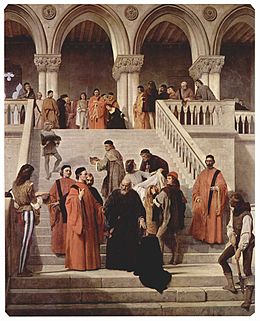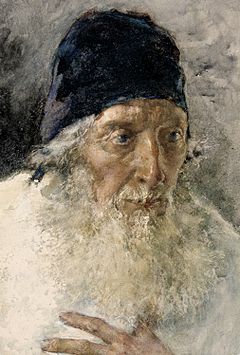Marino Faliero
Marino Faliero (* 1274 ; † April 17, 1355 in Venice ; mostly just Marin Falier ) was the 55th Doge of Venice, his appointment took place on September 11, 1354. The family provided three doges with Vitale Faliero , Ordelafo Faliero and Marino Faliero .
Life
Faliero was a member of the Council of Ten several times , he was the naval commander in Constantinople and Podestà of Padua , Treviso and Chioggia . As a diplomat he had worked in Austria, in Genoa, with the Hungarian king and at the court of Innocent VI. excellent in Avignon . As admiral of the Black Sea Fleet, he had participated in the battle of 1352 on the Bosporus. In Venice he was a member of a commission that was supposed to take action against usury. During his time on the Council of Ten , he had taken part in the trial of the conspirator Baiamonte Tiepolo .
Faliero was married to Aluicha Gradenigo. He had a daughter, Lucia.
The Doge's Office
Faliero took up his doge office in difficult times. Venice's population had halved because of the plague that had spread to the city since 1347. In 1354 there was a bitter defeat of the Venetians against Genoa at Methoni ; a large part of their fleet was captured and burned in Portalonga . 5000 men were taken prisoner, including the fleet commander and former war hero Niccolò Pisani , who was no longer allowed to hold offices after his release from Genoese captivity and was sentenced to a severe fine.

The Conspiracy
Faliero was accused of planning a coup d'état in 1355 to elevate himself to prince, possibly inspired by the example of other northern Italian families. However, Faliero was already 80 or 81 years old at this point, elected for life and had no male offspring.
The exact circumstances of the alleged conspiracy can no longer be reconstructed, as all court files were destroyed in the course of the Damnatio memoriae , and the statements of contemporaries are contradictory and interspersed with legends and rumors.
The Grand Council had apparently got information from informers about a planned coup, whereupon a number of suspected conspirators were arrested and a special court was convened. 11 of these people, including the proto of the Doge's Palace , Filippo Calendario , were hung up in front of the Doge's Palace , others were banished from Venice and Faliero himself was on the same staircase on April 17th (“Scala Foscara” or “Scala del Piombo” because of their permanent roofing , 1618 removed) beheaded on which he had been crowned Doge in September last year.
photos
Instead of a Doge portrait, in the space reserved for Marino Faliero in the Gallery of Doge Pictures in the Hall of the Great Council ( Sala del Maggior Consiglio ), there is a black banner with the white inscription: Hic est locus Marini Faletri decapitati pro criminibus (Here is the place of Marino Faliero, beheaded for a crime). It was placed on this spot by Tintoretto after his death , also a symbol for the condamnatio memoriae (the obliteration of memory) of the Doge. The existing painting is said to have been painted over with the banner.
Tomb
The doge was buried in the Faliero family chapel in SS. Giovanni e Paolo . The grave has not been preserved.
Marino Faliero in art, literature and music
- Carl Wilhelm Kolbe the Elder : Doge and Dogaressa , painting, 1816, Berlin.
- Ernst Theodor Amadeus Hoffmann : Doge and Dogaresse , story, Frankfurt a. M. 1818.
- Lord Byron : Marino Faliero , historical tragedy, Paris 1821.
- Jean François Casimir Delavigne : Marino Faliero , drama in five acts, 1821.
- Eugène Delacroix : Le Doge Marino Faliero condamné à mort , painting, 1826, London.
- Gaetano Donizetti : Marino Faliero , Tragedia lirica by Giovanni Emanuele Bidera based on the drama by Casimir Delavigne, March 12, 1835, Théâtre-Italien, Paris.
- Francesco Hayez : Gli ultimi momenti del doge Marin Faliero sulla scala detta del Piombo , painting, 1867, Pinacoteca di Brera, Milan.
- Heinrich Kruse : Marino Faliero , tragedy, Leipzig 1876.
- Martin Greif : Marino Falieri , tragedy, Vienna 1879.
- Algernon Charles Swinburne : Marino Faliero , tragedy, London 1885.
Quote
His temperament was stronger than his understanding, his heart could not find satisfaction in the highest dignity, for he had entered the Doge's Palace with his left foot. Petrarch
Individual evidence
- ↑ Peter Cochran: MARINO FALIERO, DOGE OF VENICE AN HISTORICAL TRAGEDY, IN FIVE ACTS . by Lord Byron (PDF; 1.5 MB)
Web links
| predecessor | Office | successor |
|---|---|---|
| Andrea Dandolo |
Doge of Venice 1354 - 1355 |
Giovanni Gradenigo |
| personal data | |
|---|---|
| SURNAME | Faliero, Marino |
| ALTERNATIVE NAMES | Falier, Marin |
| BRIEF DESCRIPTION | 55. Doge of Venice |
| DATE OF BIRTH | 1274 |
| DATE OF DEATH | April 17, 1355 |
| Place of death | Venice |


